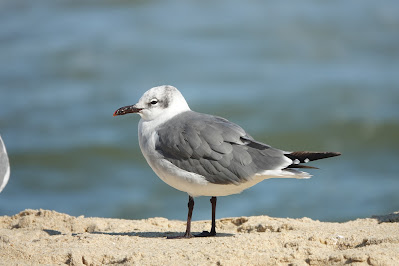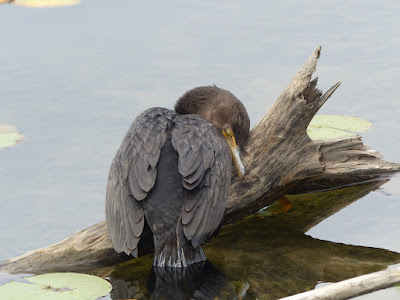Birding Under the Influence: Cycling Across America in Search of Birds and Recovery, by Dorian Anderson, Chelsea Green Publishing, 2023.
The last time I finished reading a good Christmas gift book for birders was Birding Without Borders by Noah Stryker, and right around this time of year, too. At that time I was so busy I did not get my review out until New Year's Eve. I'm not nearly so busy now, so will not make the same mistake with this book review.

My reading comes from being a birder who followed Dorian Anderson's daily blog, Biking for Birds, during his 2014 Big Year. At that time I knew nothing about him. He seemed to have burst out of nowhere and his gritty, honest and skillful effort was startling. Unfortunately, Dorian Anderson shut down his Biking for Birds blog after completing his Big Year. As just one of his hundreds of daily blog readers, I made my own impassioned argument against shutting it down. But, he did, and started his new blog, The Speckled Hatchback, instead. This blog had been inactive but he has now revived The Speckled Hatchback to promote his book and share some new photographs. He also has a website, doriananderson, which I think birders, especially, will enjoy. As I was doing all of this research, one thing I am certainly aware of, Dorian Anderson does not need my review to help him promote his book.
A few months ago, I attended a Zoom presentation offered by Orion Magazine featuring J. Drew Latham and Jonathan Franzen, both birders and both writers who need no introduction to readers. Jonathan Franzen made the argument that good nature writing should also include the human element, connection, tension or drama to the thing that is being written about. Franzen wrote the introductory essay making this argument for the Orion published Spark Birds which the Zoom presentation was promoting. His essay was also published in The New Yorker and is provided in the link to his name. I agreed with Franzen as this is true for the nature writing I enjoy most. Franzen mentioned another Big Year book, Kingbird Highway by Kenn Kaufman, and this book is also mentioned by Anderson in his book.
Okay, okay, so after all of this introduction, what about Birding Under the Influence? Should you read it? My answer is an unequivocal yes. Dorian Anderson hits all of the high notes in Birding Under the Influence. It is propulsive and compulsive reading. You do not have to be a birder to find his book deeply compelling. As I read, I kept asking myself, how could this have been possible?
Anderson's book weaves the story of his birding, his stunning academic success and research science career, his astonishing alcohol and drug abuse and meeting the woman he loves, now his wife Sonia (and to whom he dedicates his book), together in one seamless narrative. I love this style of narration and his use of it is very effective even if, occasionally, a little forced. Nevermind, it doesn't matter. You will get it and appreciate it. (For the October 12, 2023 ABA podcast episode, host Nate Swick interviewed Dorian Anderson who admitted that his entire education had focused entirely on science and math and included only scientific writing. He had no academic Fine Arts background to speak of so while writing he had to learn all of his narrative skills and techniques from scratch.)
Occasionally, for me at least, a few of his metaphors go awry and made me groan, as on page 121, "With pine scent tickling my nose and birdsong tap-dancing on my tympanum, I made halting progress toward the tundra." Here he is writing about his White-tailed Ptarmigan pursuit and where other metaphors do work. A couple of pages later he writes "... the ptarmigan forced a humbling recalibration; where I struggled to survive, the unbreakable bird thrived." At the conclusion of the same chapter and referencing his first, and unsuccessful, attempt at sobriety he writes, "Like a cramped calf muscle, hindsight and regret prevented me from overcoming the steep but surmountable hill in front of me." For my money, beautiful.
Anderson's writing also reveals his big and extroverted personality. This is on nearly every page. Despite everything he put himself through, he had many friends and colleagues who liked and respected him. A few made efforts to help him and who, until he meets Sonia, were thwarted. So committed was he to his drinking and drug use and his rationalization for it, that even Sonia was very nearly thwarted. As an aside, he seemed to have had a somewhat challenging relationship with his parents. He doesn't treat this with any depth but, just prior to setting off on his Big Year, we are given a glimpse of this.
As it happens, I have met Dorian twice. The first time was about six months following his big year at one of his university speaking engagements. A good friend sponsored Dorian's visit to speak with his students and gave a small dinner gathering the evening before Dorian's talk. My friend is a very good cook and, of course, plenty of wine was consumed - not by Dorian though. When the evening was finished I was chosen to drive Dorian to his hotel for the night. I had consumed my own fair share of wine and was nervous. Dorian, however, didn't seem to be. He chatted away on the short drive. When I dropped him off he thanked me. The next afternoon his talk with the students was a success. More recently, I met him this past spring, in May, at the famous Magee Marsh migration hot spot in northern Ohio along Lake Erie. Dorian was there with Tropical Birding, who each year sponsor the Biggest Week in American Birding event. I recognized Dorian as soon as I saw him. I stopped and, though I am certain he had no recollection of me, somehow we connected. I reminded him of our meeting at the dinner my friend gave and of giving him a ride to his hotel. He definitely remembered my friend and even recalled a piece of advice my friend had offered. The boardwalk was crowded and Dorian, along with his Tropical Birding colleague, stopped to talk. He spoke as if I was a long lost friend. This is a special skill and not one I typically associate with birders. Rather, this suggests to me that he honed his people skills outside the realm of birding. This is also supported in his writing. He spoke to me about his book and gave me a publisher-prepared flyer. I told Dorian I would pre-order it as soon as I got home. I did, and it arrived in my mailbox early this month.
I don't think it's unfair for me to write that Birding Under the Influence is not great literature. It is, however, very fair and honest for me to write that it is great reading. It is for birders absolutely, but not only for birders; cyclists, adventurers, academics, recovered and recovering persons, dreamers and many others can all enjoy this great read. Mostly, I recommend reading Birding Under the Influence for anyone who appreciates and admires great effort.
Afternote: I like the publisher that Dorian chose for his book (I am assuming he had a choice). Chelsea Green is a green publishing house and certainly this is congruent with observations and values Dorian occasionally expresses in his book; and indeed, with his whole biking adventure. He never once cheated. It's also an employee-owned company. What's not to like. I also like that the first edition of this book was released in softcover. Very easy to read and unpretentious.
On the other hand, I didn't like that, on his blog, Dorian linked his book to Amazon for purchasing. I get it though. 100%. Recognizing that most people use Amazon, this is the easiest way to get his book into readers' hands. Perfectly understandable. This is the goal of every author.
However, may I make a plea for ordering from either Barnes & Noble or your local independent bookseller, if you have one. Neither will be likely to have this book on their shelves (B&N and the independent bookseller I visit do not); it will need to be ordered. So it's the same, no matter what, just not from Amazon. My B&N order arrived exactly on time from the release date. I am a B&N member so shipping was free. I am also a member with the independent bookseller, but I have never ordered a book from them. I'm guessing, but it seems that to be competitive shipping would be free. So, I'm also encouraging membership with B&N and your local bookseller. Finally, you can also order the book directly from Chelsea Green Publishing.
When I wrote at the top of this review, "I am not nearly so busy now," I was writing the truth.
Just to reread and remind myself of Noel Stryker's 2015 birding around the world big year, I include that review here: Year end book review: Birding Without Borders, from 12/31/2017.
























































